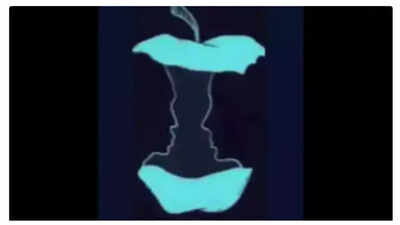Optical illusions continue to captivate audiences, providing both mental exercise and a fascinating glimpse into our perception. These visual puzzles challenge our observational skills and offer a unique form of entertainment. An optical illusion arises when our brain misinterprets the information our eyes transmit, leading us to perceive things differently from reality. For instance, a static image might appear to be in motion, or two identical shapes might seem to vary in size.

The image above, originally shared by Marina Winberg on social media, presents a classic dual-illusion. At first glance, viewers may discern either an eaten apple or two faces. According to Winberg, your initial perception reveals a fundamental aspect of your personality. Take a moment to study the image carefully; your interpretation holds the key to unlocking insights about yourself.
Winberg explains, "This image is a classic dual-illusion where you can either see two faces (a man and a woman) looking at each other OR an apple core—what you notice first says a lot about your mindset!"
If You See Two Faces First:
According to Marina, spotting the two faces first suggests, “You’re a logical, analytical thinker with strong morals. You think before you act, value stability, and solve problems creatively— but sometimes, curiosity gets the best of you!”
If You See an Apple First:
Marina notes that those who see the apple core first are, “intuitive, emotionally aware, and great at reading subtle cues. You know the right thing to say, but often stay quiet. Stability matters to you, and you protect what’s important.”
Optical illusions are not merely tricks of the eye; they are complex interactions between our visual system and our brain's interpretation of the world. These illusions can be categorized into three primary types:
Literal Illusions: These occur when the brain pieces together elements of an image to form a perception that isn't truly there. A prime example is the dual-image illusion, where the image can be perceived as either two faces or an apple core.
Physiological Illusions: These illusions result from overstimulation of the visual system. Excessive exposure to light, movement, or color can lead to effects such as afterimages or the illusion of motion.
Cognitive Illusions: Cognitive illusions stem from the brain's subconscious interpretation of information. Examples include the famous Müller-Lyer illusion, where lines appear to be of different lengths due to the surrounding shapes.
Newer articles
Older articles
 Samsung Unveils Galaxy A35 5G and A55 5G Prices, Launching with Attractive Deals
Samsung Unveils Galaxy A35 5G and A55 5G Prices, Launching with Attractive Deals
 SA20 Auction: Teams Allowed to Retain Up to Six Players, RTM Card Introduced, and Salary Cap Boosted
SA20 Auction: Teams Allowed to Retain Up to Six Players, RTM Card Introduced, and Salary Cap Boosted
 Mirabai Chanu Reveals Relentless Weightlifting Focus: Family Time Can't Dim Training Mindset
Mirabai Chanu Reveals Relentless Weightlifting Focus: Family Time Can't Dim Training Mindset
 Tottenham Signs Japan's Kota Takai to Bolster Defense
Tottenham Signs Japan's Kota Takai to Bolster Defense
 Political Power Dressing: 5 Style Secrets from New York Assemblyman Zohran Mamdani
Political Power Dressing: 5 Style Secrets from New York Assemblyman Zohran Mamdani
 5 Science-Backed Tiny Habits for a Dramatically Healthier Heart
5 Science-Backed Tiny Habits for a Dramatically Healthier Heart
 FIFA Club World Cup 2025: Upsets, Underdogs, and Heat Waves Define Group Stage as Round of 16 Beckons
FIFA Club World Cup 2025: Upsets, Underdogs, and Heat Waves Define Group Stage as Round of 16 Beckons
 Rohit Sharma Hails Barbados as India Celebrates T20 World Cup Victory
Rohit Sharma Hails Barbados as India Celebrates T20 World Cup Victory
 Gill Needs 'Attitude Adjustment' Warns Haddin After India's Test Defeat
Gill Needs 'Attitude Adjustment' Warns Haddin After India's Test Defeat
 7 Proven Strategies to Help Kids Beat Distractions and Boost Focus
7 Proven Strategies to Help Kids Beat Distractions and Boost Focus